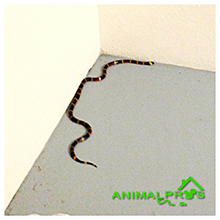Eastern Coral Snake (Micrurus fulvius)

Eastern Coral Snake
Venomous
- Length: 18″-31″
- Diet: Carnivorous, eating amphibians, rodents, and insects.
- Breeding: Starts in March through June.
- Gestation: 57 – 60 Days.
- Reproduction: 3-13 eggs, hatchlings appearing starting early fall.
- Habitat: Urban areas with the availability of food, water, and shelter, under logs, ditches, and dense undergrowth.
- Legal Status: Common throughout North Carolina, and under no protection. It is illegal to harm, capture, or remove from the wild.
- Other Names: Scarletsnake, American Cobra, Candystick, and Common Coral.
- Interesting Facts: The Eastern Coral Snake is well known for the saying, “red next to yellow, kill a fellow”, displaying very colorful rings of black, red, and yellow. For a defense mechanism, the coral snake uses disruptive patterning, confusing a threat, as they won’t know which end is the head or tail.
The Eastern Coral Snake (venomous), often referred to as the candy stick snake, is one of the most misidentified snakes found in North Carolina. Resembling scarlet king snakes (non-venomous) in color, having bands of red, black, and yellow, the venomous eastern coral snake, will have red bands touching yellow. Both snakes inhabit the same areas. Just remember, “if red touches yellow, your a dead fellow” and “if red touches black, you are alright jack”. The coral snake is extremely venomous, and is capable of injecting a neurotoxic venom, that is deadly.
As a defense mechanism, the coral snake will erratically
